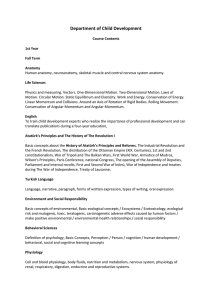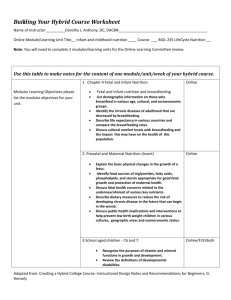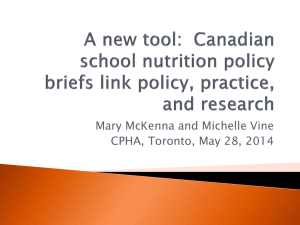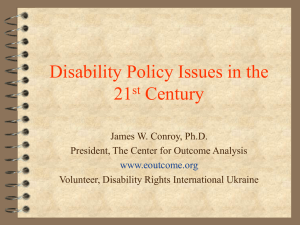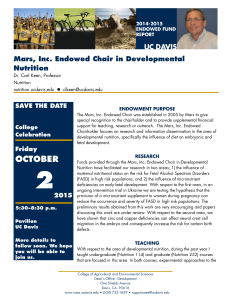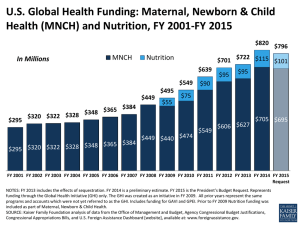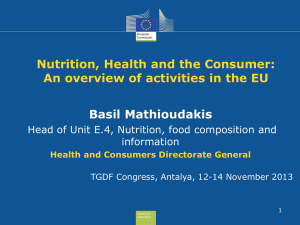View the Slides - University Center for Excellence in Developmental
advertisement
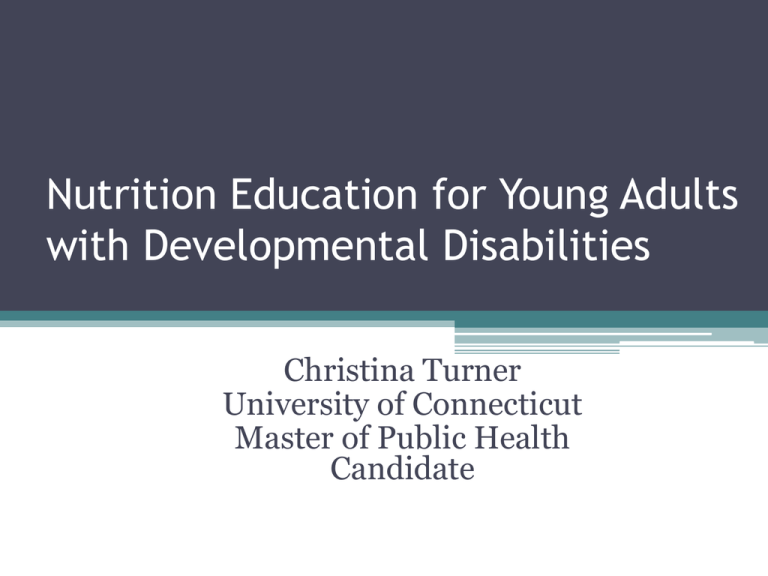
Nutrition Education for Young Adults with Developmental Disabilities Christina Turner University of Connecticut Master of Public Health Candidate Background • Overweight and Obesity growing public health issue in United States • Two-thirds of American adults overweight or obese • Estimated that adults with developmental disabilities have same or high prevalence than general population • Complex issue…CDC highlights need for nutrition education as one approach to help curb epidemic Background • Research indicates individuals with developmental disabilities, living in the community, are at risk for malnutrition….under or over nourishment • Healthy People 2010…nutrition in those with developmental disabilities as a component of nation’s public health agenda • Levels significantly have increased for those living in the community..higher than living in institutions ▫ Living with families, independently, or in group homes • Can affect participation within the community, independent living, and healthy life years Background • Patterns in data indicate adults with developmental disabilities are lacking support in making food selections and consume inadequate amounts of some nutrients and food groups, and too much of other food groups • Predicted that without effective interventions overweight/obesity in this population will become massive • Due to great availability and access to unhealthy foods, those living in the community need increased nutrition education. Background • Nutrition education interventions for this population should be visual, interactive, and culturally appropriate. • Research is lacking in this topic Purpose • To develop a nutrition education activity that increases nutrition knowledge in young adults with developmental disabilities, using a visual, interactive, and culturally appropriate approach. Methods • “The Five Food Groups” activity developed ▫ Challenges students to correctly identify foods that belong to each food group • Implemented to 5 students in Special Education classroom containing 18-21 year olds after reading lesson from textbook. • Evaluated by pre/post test and teacher observation Methods • Created additional activities not evaluated at this time ▫ “Grocery Store Treasure Hunt”, “Food Journal”, “Reading Nutrition Labels”, “Eating Responsibly Crossword Puzzle”, “Eating Responsibly Word Search”, and “Fruits and Vegetables Word Search”. • Provided healthy recipes to be used in a Vocational Education Class Results • Class Average Pre-Test Score = 31%, (median= 21.7%; range= 7.1%-71.4%) • Class Average Post-Test Score = 91.1% (median= 92.9%; range= 85.7%-92.9%) ▫ Percentages indicate that the class average improved after the implementation of the activity. The activity seemed to increase nutrition knowledge among the students Results • Teacher Observational Evaluation: ▫ Students were engaged during entire activity ▫ Frustration levels were minimal ▫ Activity spurred conversation about food groups during lunch ▫ Students performed additional internet searches after completing the activity Results • Student Evaluation: ▫ Enjoyed the use of color: activity very visual ▫ Hands-on activity—interactive • Staff Evaluation ▫ Appreciated use of culturally diverse/appropriate foods Ex: Collard Greens • Teacher Evaluation: ▫ Appreciated age and academic appropriateness Difficult to find activities both appropriate for age and academic level Conclusions/Recommendations • Small sample size..other teachers should implement activity for further evaluation • Implementation and completion of activity positive experiences for staff and students • Recommended that teacher share activity with other teachers and curriculum coordinator • Teacher should implement and evaluation other created activities • The use of visual, interactive, and culturally appropriate materials should apply to all subjects Interdisciplinary • Public health and education professions • Continuous collaboration with teacher and school staff Systems Change • Improve curriculum for educating young adults with developmental disabilities, about nutrition • Can eventually be presented to other Special Education teachers and curriculum coordinator…encouraged to be used school wide
